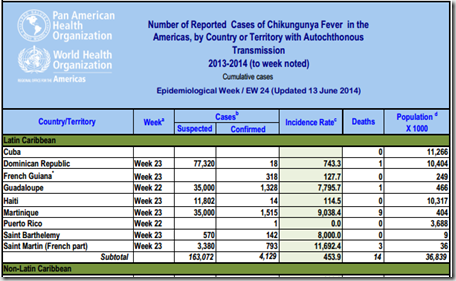# 8742
The Chikungunya virus – which was only first reported in this hemisphere last December on the French Part of St. Martins - continues to spread across the Caribbean and make incursions into Central and South America at an impressive rate.
Two weeks ago (see PAHO Chikungunya Epidemiological Update – May 30th) the estimated number of cases had grown to just over 100,000 – today that number exceeds 165,0000.
As impressive as these growth numbers are, it should be noted that surveillance in some of the reporting nations is sub-optimal, and in some cases, reporting to PAHO lags behind by several weeks. Meaning the number of reported cases today is likely to be an undercount.
First a look at the latest numbers, then I’ll be back with more:
The hardest hit areas are islands in the `Latin Caribbean’, which have reported more than 90% of all of the cases in this outbreak to date. Particularly hard hit are Martinique and the Dominican Republic, although anecdotal reports suggest the situation in Haiti is badly underreported.
While lagging well behind, the Non-Latin Caribbean nations have reported a roughly 30% increase in cases over the past two weeks.
And lastly, a look at nations that have reported imported Chikungunya cases – but as of yet, no local transmission of the virus.
While this virus has spread quite efficiently through just the normal tourist trade and international travel, this week the month-long FIFA World Cup begins in Brazil, which is expected to draw more than 500,000 visitors. And among them will be some who either reside in, or have recently visited, areas where this virus is currently spreading (see The ECDC Risk Assessment On Brazil’s FIFA World Cup).
With an incubation period of between 3 and 7 days, and the enormous amount of international travel to, and from, the Caribbean, the concern is that this virus will soon migrate to other areas that also have a favorable climate and the right kind of mosquitoes.
In April, in Study: Chikungunya’s Growing Threat To The Americas, we looked at models showing how the spread of CHKV could be aided and abetted by the spike in travelers to the World Cup this summer.
Until about a decade ago, the Chikungunya virus was fairly localized in Central Africa, and only believed transmitted by the Aedes Aegypti mosquito. In 2005 the virus took off on the wings of the Aedes Albopictus mosquito, and quickly conquered the Indian Ocean and parts of Asia, and moved into the Pacific.
Between the two, these mosquito vectors cover a lot of territory, including much of the Eastern United States and Southern Europe.

While no one knows how well the virus will spread, once it gets a foot hold in the United States or Europe, public health agencies are trying to be as proactive as they can in anticipation of its arrival. The state of Florida is concerned enough that it has issued warnings to the public, and is actively Preparing For Chikungunya.
In March the CDC held a Chikungunya Webinar, in December they released a CDC HAN Advisory On Recognizing & Treating Chikungunya Infection, and just last week the MMWR published a report on Chikungunya In the Caribbean & South America.
Chikungunya – while rarely fatal, can cause prolonged fever and severe polyarthralgias (joint pain), which in some cases can last weeks, months, or even longer.
While the kind of widespread epidemic we are seeing in the Caribbean seems highly unlikely in the United States or Europe (based primarily on differences in lifestyle, better mosquito control, and other socio-economic factors), no one really knows what will happen when this emerging arbovirus, aided and abetted by a pair of competent and ubiquitous vectors, is introduced to a highly susceptible and immunologically naive population.
But considering Chikungunya’s remarkable run over the past 10 years, it seems likely that this virus will continue to spread to new territories, bringing with it serious public health challenges.



